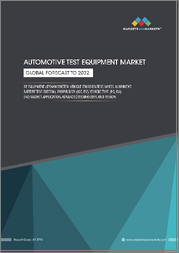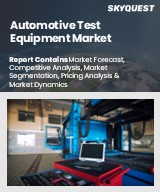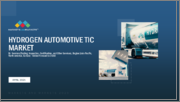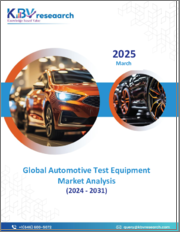
|
시장보고서
상품코드
1833393
자동차 시험 장비 시장 기회, 성장 촉진요인, 산업 동향 분석 및 예측(2025-2034년)Automotive Test Equipment Market Opportunity, Growth Drivers, Industry Trend Analysis, and Forecast 2025 - 2034 |
||||||
자동차 시험 장비 세계 시장 규모는 2024년에 53억 달러로 평가되었고, CAGR 5.2%로 성장하여 2034년에는 87억 달러에 이를 것으로 예측됩니다.

첨단 전자장치와 차세대 첨단운전자보조시스템(ADAS)의 통합이 진행되면서 테스트 장비의 역할이 재편되고 있으며, 기존의 진단 도구에서 실제 주행 상황을 재현할 수 있는 고도의 첨단 시스템으로 변화하고 있습니다. 특히 업계가 ADAS 개발, 차량 커넥티비티, 자율주행 기능을 추진함에 따라 자동차 제조업체와 1차 협력업체들은 다양한 주행 시나리오를 시뮬레이션하기 위해 고성능 테스트 벤치에 대한 투자를 늘리고 있습니다. 자동차의 복잡성, 전기 모빌리티의 확대, 개발 및 규제 준수에 대한 정확성에 대한 요구가 증가함에 따라 최첨단 테스트 솔루션에 대한 수요는 지속적으로 증가하고 있습니다. 전동화는 규제 변화와 함께 OEM 및 애프터마켓 업체들이 모듈식, 확장성, 지능형 테스트 플랫폼을 채택하도록 유도하고 있습니다. 자동화된 클라우드 지원 진단도 주류가 되어가고 있으며, R&D 라인과 생산 라인 모두에서 제품 개발의 속도, 정확성, 효율성을 향상시키고 있습니다. 시장의 궤적은 진화하는 차량 아키텍처와 세계 배기가스 규제에 대응하기 위해 보다 스마트하고 유연한 시스템으로 전환하는 것을 반영하고 있습니다.
| 시장 규모 | |
|---|---|
| 개시 연도 | 2024년 |
| 예측 연도 | 2025-2034년 |
| 시장 규모 | 53억 달러 |
| 예측 금액 | 87억 달러 |
| CAGR | 5.2% |
파워트레인 테스트는 전기 파워트레인으로의 전환에 힘입어 여전히 가장 큰 응용 분야입니다. OEM은 배터리의 주행거리, 모터의 기능성, 인버터의 신뢰성을 보다 정확하게 평가하기를 원하고 있으며, 이에 따라 변화하는 EV 기술 및 지역 충전 표준에 따라 적응성과 확장성을 갖춘 테스트 셋업에 대한 관심이 높아지고 있습니다. 이 분야는 자동차의 전동화가 대중화됨에 따라 계속 진화하고 있습니다.
섀시 동력계 부문은 2024년 33%를 차지할 것이며, 2034년까지 연평균 3%의 연평균 복합 성장률(CAGR)을 보일 것입니다. 이러한 시스템은 시뮬레이션된 도로 조건에서 완벽한 차량 테스트의 중심이 되어 연비 평가, 배기가스 모니터링, 동적 성능 테스트를 지원합니다. 국제 배기가스 규제가 강화됨에 따라 하이브리드 자동차 및 전기자동차에 대응하는 동력계 수요가 증가하고 있습니다. 또한, 이들 시스템은 회생 제동 평가 및 고전압 EV 테스트 기능을 통해 그 유용성을 확장하고 있습니다.
승용차 부문은 2024년 71%의 점유율을 차지할 것으로 예상되며, 2025년부터 2034년까지 연평균 복합 성장률(CAGR) 6%의 성장을 유지할 것으로 전망됩니다. 특히 하이브리드 및 전기자동차의 경우 시스템의 복잡성이 증가함에 따라 OEM 및 서비스 제공업체는 첨단 배기가스 분석기, 배터리 테스트 시스템, 다기능 진단 도구로 테스트를 강화해야 합니다. ADAS와 인포테인먼트 플랫폼의 통합이 진행됨에 따라 자동화된 소프트웨어 기반 테스트 환경의 채택이 증가하고 있습니다. 애프터마켓 도구 중 배터리 테스터는 EV 차량 및 서비스 요구 사항의 세계 확장에 따라 배터리 테스터가 가장 강력한 성장을 보이고 있습니다.
미국 자동차 테스트 장비 2024년 시장 규모는 9억 6,290만 달러에 달할 것으로 예측됩니다. 성숙한 자동차 생산 환경과 탄탄한 애프터마켓 생태계를 바탕으로 북미의 주요 시장 기업로 자리매김하고 있습니다. 자동차 소유 수준이 높고 전기자동차에 대한 관심이 높아지면서 배기가스 시험기, 브레이크 시험 시스템, 디지털 진단 장비에 대한 수요는 계속 강세를 보이고 있습니다. SUV와 소형 트럭의 보급은 OEM과 애프터마켓의 시험기 수요에 더욱 박차를 가하고 있습니다.
자동차 시험장비 시장을 형성하는 유력 기업으로는 무그, 소프팅, 호리바제작소, AVL List, 지멘스, ABB, 액티어, 콘티넨탈, 로버트보쉬, 허니웰 등이 있습니다. 자동차 테스트 장비 시장의 주요 기업들이 채택하는 주요 전략은 전기자동차, 하이브리드 자동차, 소프트웨어 정의 자동차의 진화하는 수요에 대응하기 위해 기술 혁신을 가속화하는 것입니다. 각 기업은 실시간 진단 및 예측 분석을 가능하게 하는 모듈식 및 AI 지원 테스트 플랫폼 개발에 투자하고 있습니다. 또한, 클라우드 연결과 원격 테스트 기능을 중시하여 다양한 용도로 확장성을 가지고 있습니다. OEM 및 연구센터와의 전략적 제휴는 제품 역량 확대에 도움이 되고 있으며, 규제 대응과 지속가능성은 환경적으로 효율적인 시스템 구축에 힘을 실어주고 있습니다. 각 회사는 사용자 경험과 장기적인 가치를 높이기 위해 세계 서비스 및 지원 인프라를 더욱 강화하고 있습니다.
목차
제1장 조사 방법
- 시장 범위와 정의
- 조사 디자인
- 조사 접근
- 데이터 수집 방법
- 데이터 마이닝 소스
- 세계
- 지역/국
- 기본 추정과 계산
- 기준연도 계산
- 시장 예측 주요 동향
- 1차 조사와 검증
- 1차 정보
- 예측 모델
- 조사 전제와 한계
제2장 주요 요약
제3장 업계 인사이트
- 생태계 분석
- 공급업체 상황
- 이익률
- 비용 구조
- 각 단계에서의 부가가치
- 밸류체인에 영향을 미치는 요인
- 파괴적 변화
- 업계에 대한 영향요인
- 성장 촉진요인
- 엄격한 규제 기준과 컴플라이언스 요건
- 전기자동차 시장 성장과 테스트 요구
- 자율주행차 개발과 검증
- 커넥티드카 기술 통합
- 업계의 잠재적 리스크&과제
- 고액의 자본 투자와 설비 비용
- 규제 준수 복잡성
- 시장 기회
- 전기자동차 시험 설비 확장
- 자율주행차 검증 시장 성장
- 디지털 전환과 자동화
- 클라우드 기반 테스트 플랫폼 개발
- 성장 촉진요인
- 성장 가능성 분석
- 규제 상황
- 북미
- 유럽
- 아시아태평양
- 라틴아메리카
- 중동 및 아프리카
- Porter의 Five Forces 분석
- PESTEL 분석
- 기술 및 혁신 상황
- 현재 기술 동향
- IoT 통합과 접속된 테스트 기기
- 빅데이터 분석과 예측 유지관리
- 신기술
- AI와 머신러닝 실장
- 디지털 트윈 기술 통합
- 기술 진화 타임라인
- 현재 기술 동향
- 디지털 전환과 인더스트리 4.0통합
- 시험 장비에의 IoT 통합
- 인공지능과 머신러닝
- 빅데이터 분석과 클라우드 컴퓨팅
- 디지털 트윈 기술
- 클라우드 기반 테스트 플랫폼
- 시험 장비 사이버 보안
- 가격 동향
- 지역별
- 제품별
- 생산 통계
- 생산 거점
- 소비 거점
- 수출과 수입
- 비용 내역 분석
- 특허 분석
- 기술 카테고리와 테스트 별 유효한 특허
- EV·AV시험 장비 특허 출원 동향
- IP 라이선싱 및 기술 이전 모델
- 특허 소송 리스크 평가
- 투자 및 자금조달 분석
- 설비 카테고리별 연구개발 투자
- 벤처캐피털 및 사모펀드 활동
- 정부 자금 원조와 조사 보조금
- 기업 투자·인수 활동
- 지속가능성과 환경 측면
- 지속가능한 실천
- 폐기물 감축 전략
- 생산 에너지 효율
- 친환경 대처
- 탄소발자국 고려
- 향후 전망과 업계 변혁 타임라인
- 단기적인 혼란(2025-2027)
- 중기적인 혼란(2028-2030)
- 장기적인 혼란(2031-2034)
제4장 경쟁 구도
- 서론
- 기업의 시장 점유율 분석
- 북미
- 유럽
- 아시아태평양
- 라틴아메리카
- 중동 및 아프리카
- 주요 시장 기업의 경쟁 분석
- 경쟁 포지셔닝 매트릭스
- 전략적 전망 매트릭스
- 주요 발전
- 인수합병(M&A)
- 파트너십 및 협업
- 신제품 발매
- 확장 계획과 자금조달
- 제품 포트폴리오와 기술 비교
- 혁신 리더십과 기술 개발
- 특허 출원과 IP 포트폴리오 분석
- 조사 협력과 파트너십
- 스타트업 에코시스템과 혁신
- 시장 진출 전략과 장벽
- 기술 장벽 분석
- 자본 투자 요건
- 규제와 인증 장벽
- 브랜드 인지도와 고객 신뢰
- 고객 의사결정 기준과 벤더 선택
- 기술 퍼포먼스 요건
- 비용과 총소유에 관한 고려사항
- 벤더 신뢰성과 지원
- 통합과 호환성 요인
제5장 시장 추산·예측 : 제품별, 2021-2034
- 주요 동향
- 섀시 발전기 미터
- 엔진 발전기 미터
- 휠얼라이먼트 테스터
- 배출 분석 장비
- 차량 배기가스 분석 장비
- 배터리 테스터
- 기타 진단 툴
제6장 시장 추산·예측 : 용도별, 2021-2034
- 주요 동향
- 승용차
- 세단
- SUV
- 해치백
- 상용차
- 소형 상용차(LCV)
- 대형 상용차(HCV)
- 중형 상용차(MCV)
제7장 시장 추산·예측 : 추진력별, 2021-2034
- 주요 동향
- 내연기관차
- 전기자동차
- 배터리 전기자동차(BEV)
- 플러그인 하이브리드 차(PHEV)
- 하이브리드 전기자동차(HEV)
제8장 시장 추산·예측 : 최종 용도별, 2021-2034
- 주요 동향
- 자동차 OEM
- Tier 1 및 Tier 2공급업체
- 자동차 서비스 센터와 워크샵
- 규제기관 및 시험 기관
- 조사 개발 센터
제9장 시장 추산·예측 : 지역별, 2021-2034
- 주요 동향
- 북미
- 미국
- 캐나다
- 유럽
- 독일
- 영국
- 프랑스
- 이탈리아
- 스페인
- 북유럽 국가
- 러시아
- 폴란드
- 루마니아
- 아시아태평양
- 중국
- 인도
- 일본
- 한국
- 호주 및 뉴질랜드
- 베트남
- 인도네시아
- 라틴아메리카
- 브라질
- 멕시코
- 아르헨티나
- 중동 및 아프리카
- 남아프리카공화국
- 사우디아라비아
- 아랍에미리트
제10장 기업 개요
- Global companies
- AVL List
- Horiba
- MTS Systems
- National Instruments(NI)
- Keysight Technologies
- Robert Bosch
- dSPACE
- ETAS
- ABB
- Actia
- Continental
- Honeywell
- Moog
- Softing
- Technology providers
- ANSYS
- Bruel &Kjar Sound &Vibration
- HBK(Hottinger Bruel &Kjar)
- IPG Automotive
- MathWorks
- Rohde &Schwarz
- Siemens
- Tektronix
- Vector Informatik
- Testing service providers
- Applus+
- Bureau Veritas
- DEKRA
- Element Materials Technology
- Intertek
- Millbrook Proving Ground
- SGS
- TUV SUD
The Global Automotive Test Equipment Market was valued at USD 5.3 billion in 2024 and is estimated to grow at a CAGR of 5.2% to reach USD 8.7 billion by 2034.
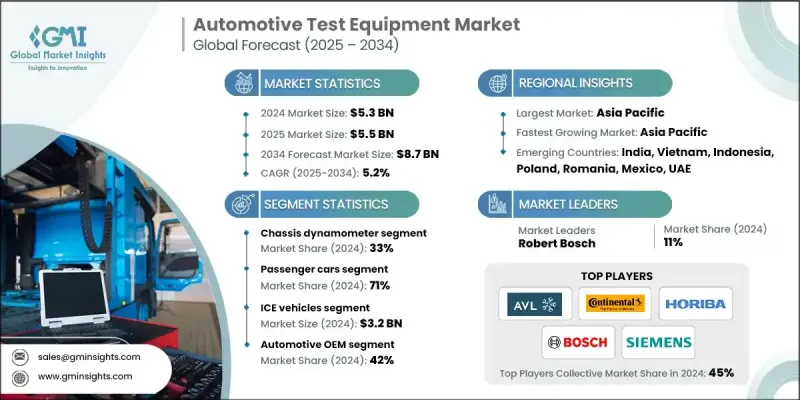
Rising integration of advanced electronics and next-gen driver assistance technologies is reshaping the role of test equipment, transforming it from traditional diagnostic tools into highly advanced systems capable of replicating real-world driving conditions. Automakers and Tier-1 suppliers are increasingly investing in high-performance test benches to simulate various driving scenarios, especially as the industry pushes forward with ADAS development, vehicle connectivity, and autonomous functionality. The demand for cutting-edge testing solutions continues to grow, driven by rising vehicle complexity, the expansion of electric mobility, and a growing need for precision in development and regulatory compliance. Electrification, along with evolving regulations, is prompting OEMs and aftermarket players to adopt modular, scalable, and intelligent testing platforms. Automated and cloud-enabled diagnostics are also becoming mainstream, improving product development speed, accuracy, and efficiency across both R&D and production lines. The market's trajectory reflects a shift toward smarter, more flexible systems that meet evolving vehicle architecture and global emission standards.
| Market Scope | |
|---|---|
| Start Year | 2024 |
| Forecast Year | 2025-2034 |
| Start Value | $5.3 Billion |
| Forecast Value | $8.7 Billion |
| CAGR | 5.2% |
Powertrain testing remains the largest application area, underpinned by the shift toward electric powertrains. OEMs are demanding greater accuracy in evaluating battery range, motor functionality, and inverter reliability, which has fueled interest in adaptive and scalable test setups that align with changing EV technologies and regional charging norms. This segment continues to evolve as vehicle electrification becomes more widespread.
The chassis dynamometers segment held 33% in 2024, with a 3% CAGR through 2034. These systems remain central to full vehicle testing under simulated road conditions, supporting fuel efficiency assessments, emissions monitoring, and dynamic performance testing. As international emissions regulations grow stricter, there's increased demand for dynamometers compatible with hybrid and electric vehicles. These systems are also expanding their utility with regenerative braking assessments and high-voltage EV testing capabilities.
The passenger cars segment held a 71% share in 2024 and is projected to maintain growth at 6% CAGR between 2025 and 2034. Increasing system complexity, particularly in hybrid and electric vehicles, is encouraging OEMs and service providers to enhance testing with advanced emissions analyzers, battery testing systems, and multi-functional diagnostic tools. The rising integration of ADAS and infotainment platforms is also encouraging the adoption of automated, software-driven testing environments. Among aftermarket tools, battery testers are experiencing the strongest growth, driven by the global expansion of EV fleets and service requirements.
United States Automotive Test Equipment Market was valued at USD 962.9 million in 2024. The country remains a key market player in North America, backed by a mature automotive production landscape and a robust aftermarket ecosystem. With high vehicle ownership levels and growing interest in electric vehicles, demand remains strong for emissions testers, brake testing systems, and digital diagnostic equipment. The prevalence of SUVs and light trucks adds further momentum to testing equipment needs in both OEM and aftermarket sectors.
Prominent companies shaping the Automotive Test Equipment Market include Moog, Softing, Horiba, AVL List, Siemens, ABB, Actia, Continental, Robert Bosch, and Honeywell. Key strategies adopted by leading players in the automotive test equipment market center around accelerating innovation to meet the evolving demands of electric, hybrid, and software-defined vehicles. Companies are investing in the development of modular and AI-enabled test platforms that allow for real-time diagnostics and predictive analytics. Emphasis is also being placed on cloud connectivity and remote testing capabilities, enabling scalability across various applications. Strategic collaborations with OEMs and research centers are helping expand product capabilities, while regulatory compliance and sustainability are driving the creation of eco-efficient systems. Companies are further strengthening global service and support infrastructure to enhance user experience and long-term value.
Table of Contents
Chapter 1 Methodology
- 1.1 Market scope and definition
- 1.2 Research design
- 1.2.1 Research approach
- 1.2.2 Data collection methods
- 1.3 Data mining sources
- 1.3.1 Global
- 1.3.2 Regional/Country
- 1.4 Base estimates and calculations
- 1.4.1 Base year calculation
- 1.4.2 Key trends for market estimation
- 1.5 Primary research and validation
- 1.5.1 Primary sources
- 1.6 Forecast model
- 1.7 Research assumptions and limitations
Chapter 2 Executive Summary
- 2.1 Industry 360° synopsis
- 2.2 Key market trends
- 2.2.1 Regional
- 2.2.2 Product
- 2.2.3 Application
- 2.2.4 Propulsion
- 2.2.5 End Use
- 2.3 TAM analysis, 2025-2034
- 2.4 CXO perspectives: Strategic imperatives
- 2.4.1 Executive decision points
- 2.4.2 Critical success factors
- 2.5 Future outlook
- 2.6 Strategic recommendations
- 2.6.1 For equipment manufacturers
- 2.6.2 For end users
- 2.6.3 For testing service providers
- 2.6.4 For investors & financial institutions
Chapter 3 Industry Insights
- 3.1 Industry ecosystem analysis
- 3.1.1 Supplier landscape
- 3.1.2 Profit margin
- 3.1.3 Cost structure
- 3.1.4 Value addition at each stage
- 3.1.5 Factor affecting the value chain
- 3.1.6 Disruptions
- 3.2 Industry impact forces
- 3.2.1 Growth drivers
- 3.2.1.1 Stringent regulatory standards & compliance requirements
- 3.2.1.2 Electric vehicle market growth & testing needs
- 3.2.1.3 Autonomous vehicle development & validation
- 3.2.1.4 Connected vehicle technology integration
- 3.2.2 Industry pitfalls and challenges
- 3.2.2.1 High capital investment & equipment costs
- 3.2.2.2 Regulatory compliance complexity
- 3.2.3 Market opportunities
- 3.2.3.1 Electric vehicle testing equipment expansion
- 3.2.3.2 Autonomous vehicle validation market growth
- 3.2.3.3 Digital transformation & automation
- 3.2.3.4 Cloud-based testing platform development
- 3.2.1 Growth drivers
- 3.3 Growth potential analysis
- 3.4 Regulatory landscape
- 3.4.1 North America
- 3.4.2 Europe
- 3.4.3 Asia Pacific
- 3.4.4 Latin America
- 3.4.5 Middle East & Africa
- 3.5 Porter’s analysis
- 3.6 PESTEL analysis
- 3.7 Technology and innovation landscape
- 3.7.1 Current technological trends
- 3.7.1.1 IoT integration & connected testing equipment
- 3.7.1.2 Big data analytics & predictive maintenance
- 3.7.2 Emerging technologies
- 3.7.2.1 AI & machine learning implementation
- 3.7.2.2 Digital twin technology integration
- 3.7.3 Technology evolution timeline
- 3.7.1 Current technological trends
- 3.8 Digital transformation & industry 4.0 integration
- 3.8.1 IoT integration in testing equipment
- 3.8.2 Artificial intelligence & machine learning
- 3.8.3 Big data analytics & cloud computing
- 3.8.4 Digital twin technology
- 3.8.5 Cloud-based testing platforms
- 3.8.6 Cybersecurity in testing equipment
- 3.9 Price trends
- 3.9.1 By region
- 3.9.2 By product
- 3.10 Production statistics
- 3.10.1 Production hubs
- 3.10.2 Consumption hubs
- 3.10.3 Export and import
- 3.11 Cost breakdown analysis
- 3.12 Patent analysis
- 3.12.1 Active patents by technology category & testing
- 3.12.2 Patent filing trends in EV & AV testing equipment
- 3.12.3 IP licensing & technology transfer models
- 3.12.4 Patent litigation risk assessment
- 3.13 Investment & funding analysis
- 3.13.1 R&D investment by equipment category
- 3.13.2 Venture capital & private equity activity
- 3.13.3 Government funding & research grants
- 3.13.4 Corporate investment & acquisition activity
- 3.14 Sustainability and environmental aspects
- 3.14.1 Sustainable practices
- 3.14.2 Waste reduction strategies
- 3.14.3 Energy efficiency in production
- 3.14.4 Eco-friendly initiatives
- 3.14.5 Carbon footprint considerations
- 3.15 Future outlook & industry transformation timeline
- 3.15.1 Near-term disruptions (2025-2027)
- 3.15.2 Medium-term disruptions (2028-2030)
- 3.15.3 Long-term disruptions (2031-2034)
Chapter 4 Competitive Landscape, 2024
- 4.1 Introduction
- 4.2 Company market share analysis
- 4.2.1 North America
- 4.2.2 Europe
- 4.2.3 Asia Pacific
- 4.2.4 LATAM
- 4.2.5 MEA
- 4.3 Competitive analysis of major market players
- 4.4 Competitive positioning matrix
- 4.5 Strategic outlook matrix
- 4.6 Key developments
- 4.6.1 Mergers & acquisitions
- 4.6.2 Partnerships & collaborations
- 4.6.3 New product launches
- 4.6.4 Expansion plans and funding
- 4.7 Product portfolio & technology comparison
- 4.8 Innovation leadership & technology development
- 4.8.1 Patent filing & IP portfolio analysis
- 4.8.2 Research collaboration & partnerships
- 4.8.3 Startup ecosystem & innovation
- 4.9 Market entry strategies & barriers
- 4.9.1 Technology barrier analysis
- 4.9.2 Capital investment requirements
- 4.9.3 Regulatory & certification barriers
- 4.9.4 Brand recognition & customer trust
- 4.10 Customer decision criteria & vendor selection
- 4.10.1 Technology performance requirements
- 4.10.2 Cost & total ownership considerations
- 4.10.3 Vendor reliability & support
- 4.10.4 Integration & compatibility factors
Chapter 5 Market Estimates & Forecast, By Product, 2021 - 2034 ($Mn, Units)
- 5.1 Key trends
- 5.2 Chassis dynamometer
- 5.3 Engine dynamometer
- 5.4 Wheel alignment tester
- 5.5 Emission analyzer
- 5.6 Vehicle exhaust gas analyzer
- 5.7 Battery testers
- 5.8 Other diagnostic tools
Chapter 6 Market Estimates & Forecast, By Application, 2021 - 2034 ($Mn, Units)
- 6.1 Key trends
- 6.2 Passenger cars
- 6.2.1 Sedan
- 6.2.2 SUV
- 6.2.3 Hatchback
- 6.3 Commercial vehicles
- 6.3.1 Light commercial vehicles (LCV)
- 6.3.2 Heavy commercial vehicles (HCV)
- 6.3.3 Medium commercial vehicles (MCV)
Chapter 7 Market Estimates & Forecast, By Propulsion, 2021 - 2034 ($Mn, Units)
- 7.1 Key trends
- 7.2 ICE vehicles
- 7.3 Electric vehicles
- 7.3.1 Battery electric vehicles (BEV)
- 7.3.2 Plug-in hybrid vehicles (PHEV)
- 7.3.3 Hybrid electric vehicles (HEV)
Chapter 8 Market Estimates & Forecast, By End Use, 2021 - 2034 ($Mn, Units)
- 8.1 Key trends
- 8.2 Automotive OEM
- 8.3 Tier-1 & tier-2 suppliers
- 8.4 Automotive service centers & workshops
- 8.5 Regulatory bodies & testing agencies
- 8.6 Research & development centers
Chapter 9 Market Estimates & Forecast, By Region, 2021 - 2034 ($Mn, Units)
- 9.1 Key trends
- 9.2 North America
- 9.2.1 US
- 9.2.2 Canada
- 9.3 Europe
- 9.3.1 Germany
- 9.3.2 UK
- 9.3.3 France
- 9.3.4 Italy
- 9.3.5 Spain
- 9.3.6 Nordics
- 9.3.7 Russia
- 9.3.8 Poland
- 9.3.9 Romania
- 9.4 Asia Pacific
- 9.4.1 China
- 9.4.2 India
- 9.4.3 Japan
- 9.4.4 South Korea
- 9.4.5 ANZ
- 9.4.6 Vietnam
- 9.4.7 Indonesia
- 9.5 Latin America
- 9.5.1 Brazil
- 9.5.2 Mexico
- 9.5.3 Argentina
- 9.6 MEA
- 9.6.1 South Africa
- 9.6.2 Saudi Arabia
- 9.6.3 UAE
Chapter 10 Company Profiles
- 10.1 Global companies
- 10.1.1 AVL List
- 10.1.2 Horiba
- 10.1.3 MTS Systems
- 10.1.4 National Instruments (NI)
- 10.1.5 Keysight Technologies
- 10.1.6 Robert Bosch
- 10.1.7 dSPACE
- 10.1.8 ETAS
- 10.1.9 ABB
- 10.1.10 Actia
- 10.1.11 Continental
- 10.1.12 Honeywell
- 10.1.13 Moog
- 10.1.14 Softing
- 10.2 Technology providers
- 10.2.1 ANSYS
- 10.2.2 Bruel & Kjar Sound & Vibration
- 10.2.3 HBK (Hottinger Bruel & Kjar)
- 10.2.4 IPG Automotive
- 10.2.5 MathWorks
- 10.2.6 Rohde & Schwarz
- 10.2.7 Siemens
- 10.2.8 Tektronix
- 10.2.9 Vector Informatik
- 10.3 Testing service providers
- 10.3.1 Applus+
- 10.3.2 Bureau Veritas
- 10.3.3 DEKRA
- 10.3.4 Element Materials Technology
- 10.3.5 Intertek
- 10.3.6 Millbrook Proving Ground
- 10.3.7 SGS
- 10.3.8 TUV SUD








